March 19, 2015 100 Picture Books: 90-86
This batch was a minor mom fail. I requested them from the mobile version of my library’s website, and somehow got odd versions of them. Two of them were Spanish, and 1 was a “book club” edition, that included 9 identical paperbacks. Whoops! I have started reading the metadata more carefully.
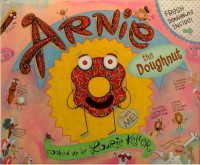 90. Arnie the Doughnut by Laurie Keller
90. Arnie the Doughnut by Laurie Keller
This book was a definite favorite. It tells the story of a doughnut named Arnie (duh), from when he is first made at 5:15am to when he is attempted to be eaten by a Mr. Bing. Arnie and Mr. Bing have to decide what to do since Arnie does NOT want to be eaten, and Mr. Bing isn’t so sure he can eat a talking doughnut. It’s pretty humorous and the book is dotted with little asides and commentary from minor characters, such as a bird or another doughnut or a customer in the bakery. Kids that are reading could probably spend a lot of time poring over all the little “Easter eggs” everywhere. Peanut did request that I change Mr. Bing to a girl, which was a pretty easy pronoun swap, and it did highlight the fact that there are no women in this book referred to by name or pronoun. Even the baker is a man. Some of the doughnuts are drawn as women, and there are a few in background scenes, but the main action is between Mr. Bing and Arnie.
I learned that the author used to design cards for Hallmark, which is pretty interesting. There may also be a stage production of this book, but I only see a mention of it with nothing to verify it.
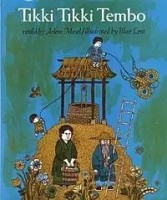 89. Tikki Tikki Tembo by Arlene Mosel
89. Tikki Tikki Tembo by Arlene Mosel
I remembered really liking this book as a kid, but Peanut wasn’t super into it. I think it was partly because the book was sort of confusing to her and partly because I accidentally got it in Spanish the first time, so Mike had to read and then translate immediately. By the time I got the English version, she was no longer interested. The story is about two brothers, the oldest having a long and important name, and the second only having one syllable. When the oldest brother falls into a well, the youngest tries to help but gets tongue tied trying to say his brother’s full name. They eventually get him out but he takes a long time to recover.
This book has an interesting back story. Apparently, the authors didn’t do much fact-checking, because the original folk tale may be Japanese rather than Chinese, and also the “names” are nonsense syllables and don’t mean what the book says that they mean. Knowing this now makes me think of the book a lot less fondly.
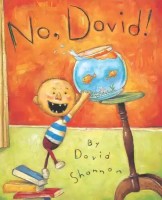 88. No, David! by David Shannon
88. No, David! by David Shannon
The same language mix-up happened with this book as Tikki Tikki Tembo. The book is very short and is basically illustrations of a toddler behaving badly and his mother saying No! a lot. Peanut definitely understood it from the pictures even in the Spanish version, and thought it was pretty funny. I thought it was kind of short and lame, and feel bad for anyone who spent the full cost of the hardcover for it.
The inner flap recounts that the book was the first the author “wrote,” as a child, about his experiences being a mischievous kid. It was apparently recovered from his childhood scribbling by his mother. This is the same author that wrote Duck on a Bike (#98). It also spawned half a dozen other David books.
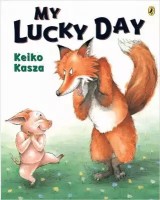 87. My Lucky Day by Keiko Kasza
87. My Lucky Day by Keiko Kasza
This book centers on a misdirection, which is easily missed by a young listener. A pig knocks at Fox’s door looking for Rabbit. Suddenly, Pig finds himself being dinner. He is resigned to this, but insists that Fox clean him, fatten him up, and massage him (to tenderize the meat, natch). During the massage, Fox passes out from exhaustion and Pig escapes. However, we discover that Pig has been hitting up all the pork-loving big bads in the forest, to get himself some quality pampering. The book doesn’t spell this out but rather shows it through the illustration. So I had to explain it, but I’m not sure that Peanut quite grasped the trick. She liked it okay, but it wasn’t as popular.
The author hails from Japan and had written several Japanese picture books before turning to English. This book is by far her most successful, although she did have some other awards for her other titles.
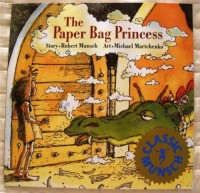 86. The Paper Bag Princess by Robert Munsch
86. The Paper Bag Princess by Robert Munsch
This was the biggest hit from this batch, for sure. I assume because there was a princess. It begins by setting the scene of Elizabeth’s princess life, which is interrupted by having her castle eaten by a dragon. The dragon drags off her betrothed, Prince Ronald, and she decides to don a paper bag (since all her clothes are fried), and rescue him. By the time she had tricked the dragon into passing out from exhaustion (a common storybook tactic, apparently), Ronald tells her she is a mess and he doesn’t want to be saved by a smelly princess. She declares Ronald to be a bum, and skips away into the sunset.
The subtle gender issues here are completely lost on a 3 year old. To her, the dragon is still the “bad guy.” It’s definitely a welcome deviation but unfortunately not appreciated at her age range.
This book is by far the most popular of all we have read so far, spawning a sea of books, media, toys, and other ephemera. It has apparently sold more than 3 million copies. You can even find a “story behind the story” book, including bios, letters, and new drawings. My favorite tidbit about this book is that apparently Munsch came across a little girl named Elizabeth who acted like a prima donna, and she became the princess in the story. Also, some versions have Elizabeth calling Ronald a toad rather than a bum.
————-
Lions and tigers and bears, oh my! Well, we’ll at least see bears in the next batch. Stay tuned for 85-81!
Written by: Meags
- Leave a comment
- Posted under Books
Leave a Reply